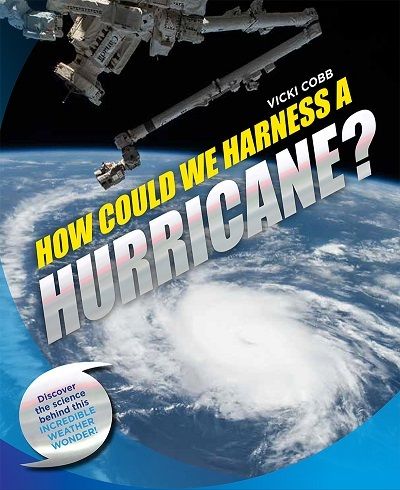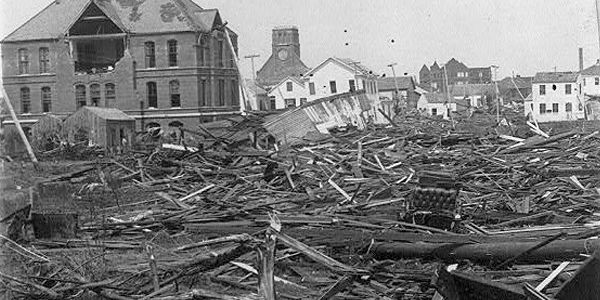
On September 8, 1900, the deadliest hurricane in US history slammed into the coastal city of Galveston, Texas. This Category 4 storm killed between 6,000 and 12,000 people. Bodies were lost in all the debris. Why so lethal? There was no warning it was coming. It simply blind-sided Galveston’s 40,000 residents. The disaster focused attention on developing the science of tracking and predicting hurricanes, thus giving people time to evacuate or batten down.

They didn’t name storms back then, but this is the hit Galveston took when a Cat 4 hurricane hit without warning.
When I planned my new children’s book, How Could We Harness a Hurricane? I intended to show how settled science, our understanding of the measurable variables—air pressure, humidity, water temperature, and wind speed—played a role in the prediction of the path of a hurricane and its potential impact upon landfall. I visited the National Hurricane Center where I learned a lot! During a major storm they send out sorties of Hurricane Hunters—aircraft (and drones called “Hurricane Hawks”) that fly into the center of the storm, as many as four times a day, to measure these variables and exactly where they were taken. They send the data back to the National Hurricane Center and other storm centers around the world to crunch the numbers. Without these measurements, taken repeatedly over time, we’d be as clueless and vulnerable to the horrors of violent weather and storm surges as the hapless folk of Galveston. Satellite images also help.
The very powerful computers at various storm centers around the world have different mathematical models, created from data of previous storms, that show a path that the current storm may take in the upcoming days. TV meteorologist show these paths from different models as spaghetti stripes. When they average them together you see “the cone of uncertainty” on the weather maps that become wider and more uncertain the further into the future they project. Nevertheless, they are useful so that people within the cone have time to make preparations.
What makes a tropical storm become a hurricane? These are the four conditions I name in my book:
1. The ocean surface water temperature must be at least 80°F (27.7°C)
2. The air around the hurricane must be reasonably moist. If it’s too dry, it will get drawn into thunderstorms that create strong downdrafts that kill the convection. Thunderstorms over the ocean are the most common ways for heat energy to be redistributed. Hurricanes do not form from thunderstorms.
3. The horizontal high winds at the top of the hurricane must not come from a direction that will blow away the tops of the clouds. This is called wind shear. Strong wind shear high up can kill a hurricane. It’s like cutting off its head and tilts the eye from a vertical to a slanted position.
4. There must first be a tropical disturbance that comes from two air masses—one hot and dry, and one warm and moist—moving over the ocean. Meteorologists are not sure quite how the disturbance becomes a hurricane. There is some force that starts it twisting, perhaps the movement of the earth below it. But this force is still unknown. They only know that this is how the hurricanes off the west coast of Africa start.
The main characteristic that separates science from all other forms of knowledge is its ability to predict. The better the data, the more accurate the prediction. Kudos to the National Hurricane Center, et al for its understanding of Harvey. Irma is on her way. Even the climate-warming deniers in her path will pay attention to the warnings and watches.
The warming climate is a slow-moving disaster in the making. You can’t cherry-pick science and heed hurricane warnings but deny climate change warnings. Or you can—and leave the Paris Accord, and pour more carbon into the air. Even if you’re in your seventies, you might live long enough to see the evidence for yourself.
